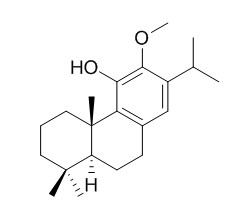11-Hydroxy-12-methoxyabietatriene
11-Hydroxy-12-methoxyabietatriene is a natural product from Salvia candidissima.
Inquire / Order:
manager@chemfaces.com
Technical Inquiries:
service@chemfaces.com
Tel:
+86-27-84237783
Fax:
+86-27-84254680
Address:
1 Building, No. 83, CheCheng Rd., Wuhan Economic and Technological Development Zone, Wuhan, Hubei 430056, PRC
Providing storage is as stated on the product vial and the vial is kept tightly sealed, the product can be stored for up to
24 months(2-8C).
Wherever possible, you should prepare and use solutions on the same day. However, if you need to make up stock solutions in advance, we recommend that you store the solution as aliquots in tightly sealed vials at -20C. Generally, these will be useable for up to two weeks. Before use, and prior to opening the vial we recommend that you allow your product to equilibrate to room temperature for at least 1 hour.
Need more advice on solubility, usage and handling? Please email to: service@chemfaces.com
The packaging of the product may have turned upside down during transportation, resulting in the natural compounds adhering to the neck or cap of the vial. take the vial out of its packaging and gently shake to let the compounds fall to the bottom of the vial. for liquid products, centrifuge at 200-500 RPM to gather the liquid at the bottom of the vial. try to avoid loss or contamination during handling.
Evid Based Complement Alternat Med.2017, 2017:1583185
Phytother Res.2022, 10.1002:ptr.7592.
Anal Bioanal Chem. 2016, 408(15)
J Formos Med Assoc.2020, S0929-6646(20)30425-3
Biochem Biophys Res Commun.2018, 505(4):1148-1153
Nutrients.2024, 16(7):985.
Plant Cell Physiol.2018, 59(1):128-141
In Vitro Cellular & Developmental Biology - Plant2022, 58:972-988.
Int J Immunopathol Pharmacol.2019, 33:2058738419857537
Environ Toxicol.2022, 37(3):514-526.
Related and Featured Products
J Agric Food Chem. 2005 Jun 29;53(13):5200-6.
Diterpenes from Salvia broussonetii transformed roots and their insecticidal activity.[Pubmed:
15969497 ]
METHODS AND RESULTS:
The new diterpenes brussonol (1) and iguestol (6alpha,11-dihydroxy-12-methoxy-abieta-8,11,13-triene) (2) with an icetexane and a dehydroabietane skeleton, respectively, have been isolated from hairy root cultures of Salvia broussonetii. Other previously known diterpenes, 7-oxodehydroabietane, 11-Hydroxy-12-methoxyabietatriene, taxodione, inuroyleanol, ferruginol, deoxocarnosol 12-methyl ether, cryptojaponol, pisiferal, sugiol, isomanool, 14-deoxycoleon U, 6alpha-hydroxydemethylcryptojaponol, demethylsalvicanol, and demethylcryptojaponol, were also obtained from these roots. The insect antifeedant and toxic effects of several of these compounds were investigated against the insect pests Spodoptera littoralis and Leptinotarsa decemlineata. Additionally, their comparative cytotoxic effects were tested on insect Sf9 and mammalian CHO cells. Demethylsalvicanol (4) was a moderate antifeedant to L. decemlineata, whereas brussonol (1) was inactive. 14-Deoxycoleon U (15) was the strongest antifeedant, whereas demethylcryptojaponol (11) was toxic to this insect.
CONCLUSIONS:
None of these compounds had antifeedant or negative effects on S. littoralis ingestion or weight gains after oral administration. Demethylcryptojaponol (11) was cytotoxic to mammalian CHO and insect Sf9 cell lines, followed by the icetexane derivative brussonol (1), with moderate cytotoxicity in both cases. The remainder of the test compounds showed a strong selective cytotoxicty to insect Sf9 cells, with demethylsalvicanol (4) being the most active.



